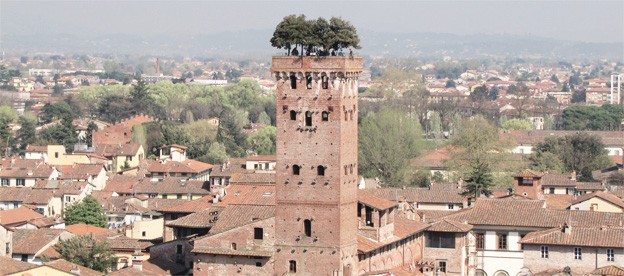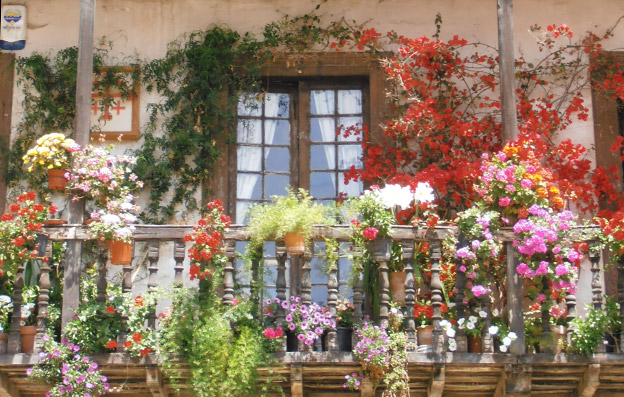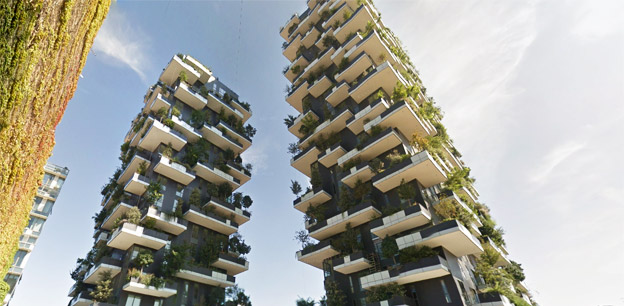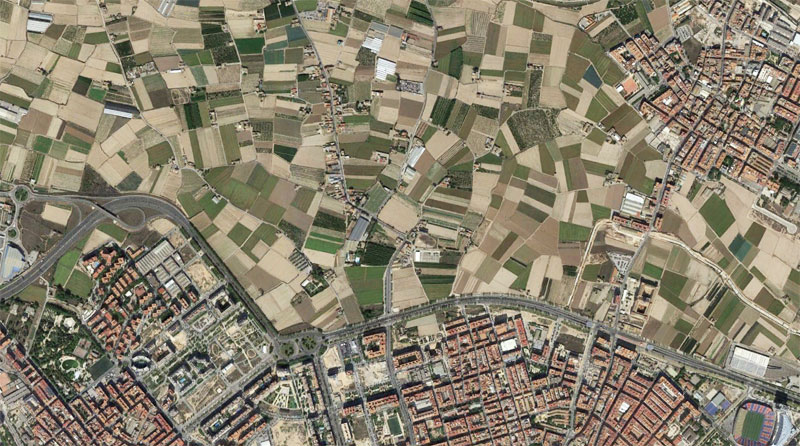
Giardino Pensile, Guinigi Tower, Lucca, Italia.
How sustainable is a tree on a roof?
28 de febrero de 2015
In recent years, many architects -especially the younger ones- have turned into the sustainability and the responsible use of natural resources as an essential key in their projects. This is an important step-forward to reduce architectural impacts on the natural environment and the land, as the European Commission has recognized the standard construction process is about 40% of the total energy consumption in the EU. Be it for conviction, be it for trending, be it for any other reason, the green impregnates most of the projects published in architecture magazines and websites. But, even if we all agree on transforming architecture into a more sustainable activity, the fact is that many of those projects are not as green as they pretend: some of the technical solutions which they use would never be required if the buildings would be properly oriented to the sun and adapted to the local climate.
Although it could be understood as a literal translation of the idea of green, the vegetation is one of the most practical elements to make greener our buildings. Among many other advantages, a plant is a natural CO2 sink which supplies O2, regulates the flows of humidity and warmth between the inside and the outside of the buildings and reduces the traffic noise in our homes, without requiring any other tools. Moreover, plants are useful to encourage recreation for citizens while making our cities more attractive and resilient. Most of times, however, we choose the plants because of their aesthetic values, colours and shapes, so the possible benefits they could give us are not really high. A very common mistake is to forget that plants need an appropriate soil to grow, with enough supplies of water, nutrients and sunlight. The ground must be deep enough and needs a particular structure to let roots grow properly. There is nothing less sustainable than periodically substituting plants and trees because they are not well-adapted to the local conditions.

Balcony with flores in Santillana del Mar, Cantabria, Spain.
Traditionally, trees and plants have been used in courtyards, such as in the cloisters of the monasteries. Flowers, climbers and other small plants in pots have always been playing the leading role on the facades: we all remember those traditional houses with their balconies covered with terracotta plant pots and flowers, or the ivy carpeting the facades of the old palaces and castles. Nevertheless, it has not been so usual to seed plants on roofs, maybe due to the sloping planes or the difficulty in checking the watertightness of the roofs when roots are growing. However, roof gardens with a wide range of plants, even trees, have become very popular today thanks to the improvements to the waterproof and the thermal insulation systems which have made possible to build flat roofs even where the climate has traditionally avoided them. Anyway, the gardens with trees on top of the buildings are not something new. A very popular example is the hanging garden with oak trees which crowns the Guinigi Tower since the 15th century in Lucca, Italy.
A green roof may be a good idea as it improves the energy-efficiency and protects both the layers of waterproof membranes and thermal insulation of the building while helping to turn the roof into a nicer, more attractive and -why not?- more productive space. Therefore, a roof garden can be a vegetable garden, a playground or even an elevated square if it is on top of a big building. And thus, a roof garden can be the best place for the residents to meet, a perfect place for social interaction. Nevertheless, is it a good idea to grow trees on the roofs? In spite of these suggestive images published in the magazines, I do not think so.
Urban trees provide a lot of positive things in urban environments: they increase the biodiversity by nesting birds, insects and small mammals; they clear the air up by fixing solid particles in suspension, sequestrating carbon dioxide from the atmosphere and releasing oxygen; they retain the ground and prevent the erosion of soils by water and wind actions; and they protect the pedestrians from the dominant winds and the summer sun. Moreover, a tree can be seen as a meeting point: under a tree people have traditionally met to talk, discuss, legislate, judge or trade. The tree, usually the oldest or the most singular, is an essential urban landmark to understand the social complexity of a population. But when we raise it up, the tree loses part of that social identity. We make it into a decorative object: something we plant because it is nice or we like it, or because it helps us to be different from some others, as the hanging garden of the Guinigi Tower, which was the representation of the Guinigi’s power in Lucca.

Two residential towers of 110 meters and 76 meters high which host a vertical forest with more than 900 trees.
Bosco Verticale, Milan, Italy. International Highrise Award, 2014. Stefano Boeri Architetti.
Although it seems the opposite, growing trees on roofs is not often a sustainable solution. We plant trees, among other reasons, to cut down the impacts of CO2 emissions into the atmosphere but a very simple calculation could help us to understand that the benefits of this CO2 sequestration are not so evident and maybe not even the best option. The premise to plant trees is that having a soil deep enough which let roots grow freely is essential: if it is not deep enough -and for trees up to 4 or 5 meters high it should be 2 meters deep at least, even if some trees could grow in less-, the roots will extend horizontally. If they cannot grow this way either, the tree will die or will turn into a small tree or a bush at best. The weight of the soil overloads the roof, which needs to be reinforced. Considering that the building has to support all kind of loads even in the worst scenario -which for a green roof, it is when the soil is completely wet after having been raining-, the roof should resist 2100kg/m2 at least for one meter deep soil -and much more if we add up the weight of the tree, which could easily reach to more than one metric ton over the years, and other use and security overloads. Most of our buildings are actually calculated to resist up to 800-1000 kg/m2, including its own weight and the overloads due to the snow accumulation and use. If we add up the new overload due to the weight of trees and soil, we will need to reinforce the structure of the building to make it resist these new overloads. That means that we should double or triple the volume of concrete in the roof and increase it in the rest of the structure as well. This is a great inconvenience since reinforced concrete is one of the most polluting materials in terms of CO2 emissions due to the manufacturing and use of portland cement, which is by far the most common type of cement around the world. It is said that one metric ton of CO2 is emitted for each cubic meter of portland cement manufactured, but this final number is actually related to many other variables, such as the consumption and type of energy used in the cement kilns, the quality of the raw materials and the transport costs. Keeping in mind the European technical rules for the design of concrete structures (Eurocode-2), cement is about the 25-30% of the total weight of concrete and is responsible for the 80% of the total CO2 emissions, which means at least 300g of CO2 emissions per each kg of concrete manufactured. What’s more, to get an approximate number we should also include in that carbon balance other type of CO2 emissions due to transportation, placing of the trees -especially when it concerns skyscrapers-, watering systems and fertilizers, and substitution of ruined trees because of a wrong plantation: actually, the trees planted on roofs are more exposed to wind and, in some cases, their branches can easily break and fall on the street.
The capacity of CO2 sequestration of a tree is related to its age and its size. A study about the most representative crops of Murcia, Spain, showed that fruit trees like lemon, orange and apricot trees could fix from 0,27 to 0,48 kg of CO2 per each kg of weight. So, a young tree could fix approximately 3 to 6 kg of CO2 per year, while an adult tree of 20 years could easily fix up to ten times that amount. However, they rarely grow more than four meters high in a roof garden and consequently their capacity to fix CO2 will be always bigger in an urban park or in a forest. In addition to this, the required distance between trees leads to low-density plantations: for example, citrus trees are usually planted in a grid of 5×5 meters, so not more than 4 trees could be planted on a roof of 100 m2. They would only fix up to 24kg of CO2 per year. In fact, we could increase the CO2 sequestration without needing a deep soil if we plant cereals or vegetables instead of trees: the roof structure would need a lower volume of concrete since the overload due to the garden would be lower too. Thus, the roof could be lighter and the CO2 emissions could be cut down as well. For example, we can plant up to 200 tomato plants in 100m2, which could fix around 160kg of CO2 per year. Part of this CO2 will return to the atmosphere when harvesting, but these losses would be compensated with a lower CO2 emissions thanks to the lower volume of concrete used when building the structure up. In any case, it is important to compare the emissions and sequestration times: it is not reasonable to compensate the CO2 emissions of one year along the next twenty years. Anyway, this is only an example: ideally, in our gardens we should use plants which are well-adapted to the local climate, with low water requirements and maintenance.

Agricultural belt: vegetable gardens of Valencia, Spain.
In my opinion, trees are fantastic actors of our cities, improving the air quality and biodiversity. We must plant them with responsibility, helping them to grow naturally. It is much smarter to strengthen and develop the green public areas like parks, gardens or squares not only for ecological but social reasons, if we really want to increase the sustainability of our cities. These places favour the social cohesion and make public areas nicer and more pleasant. All citizens should have a place nearby for talking to friends, playing, relaxing, walking, doing sport or meeting new people. Moreover, our best public place and CO2 sink is the agricultural belt which encloses all our cities: instead of planting trees on roofs, we should focus on improving our public areas to make our cities, landscapes and societies more sustainable.
Some notes:
Directive 2010/31/UE of the European Parliament and of the Council, of 19 May 2010, Parlamento Europeo y del Consejo, de 19 de mayo de 2010, on the energy performance of buildings.
Canadell, J., Jackson, R.B., Ehleringer, J.R., Mooney, H.A., Sala, O.E., Schulze, E.-D.: Maximum rooting depth of vegetation types al the global scale. Oecologia, 108 (1996)
Mota, C., Alcaraz-López, C., Iglesias, M., Martínez-Ballesta, M.C., Carvajal, M.: Investigación sobre la absorción de CO2 por los cultivos más representativos. Consejo Superior de Investigaciones Científicas (CSIC) (In Spanish)
Directive 2010/31/UE of the European Parliament and of the Council, of 19 May 2010, Parlamento Europeo y del Consejo, de 19 de mayo de 2010, on the energy performance of buildings.
Canadell, J., Jackson, R.B., Ehleringer, J.R., Mooney, H.A., Sala, O.E., Schulze, E.-D.: Maximum rooting depth of vegetation types al the global scale. Oecologia, 108 (1996)
Mota, C., Alcaraz-López, C., Iglesias, M., Martínez-Ballesta, M.C., Carvajal, M.: Investigación sobre la absorción de CO2 por los cultivos más representativos. Consejo Superior de Investigaciones Científicas (CSIC) (In Spanish)